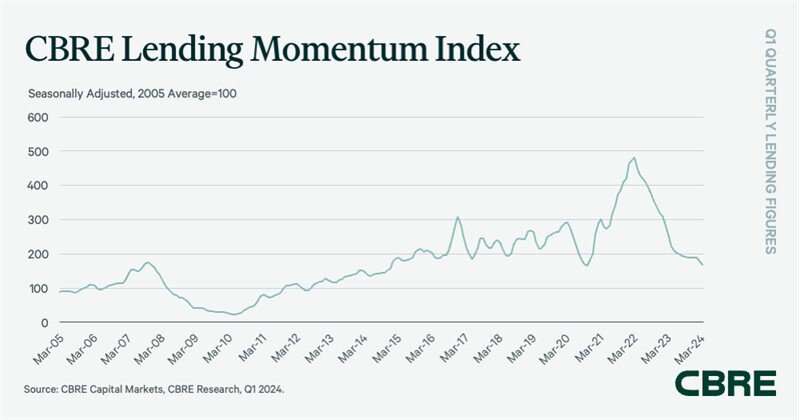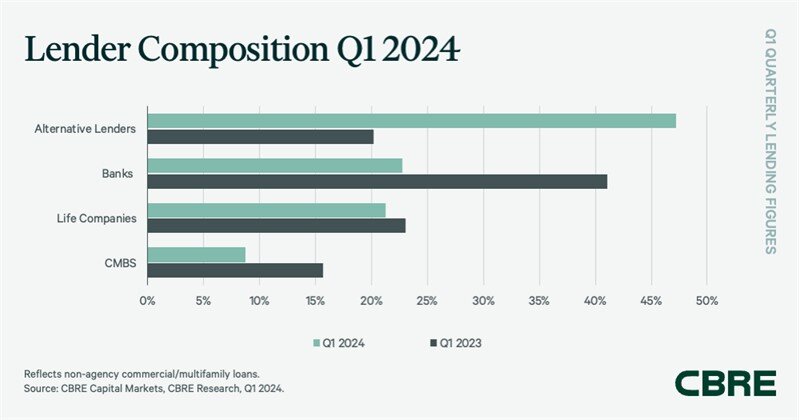Commercial Real Estate News

Commercial Real Estate Lending in U.S. Slowed in First Quarter
Commercial News » New York City Edition | By Michael Gerrity | May 16, 2024 8:28 AM ET
Based on new data from CBRE, the U.S. commercial real estate lending market slowed in Q1 2024 due to high interest rates and limited credit availability, but a tightening of credit spreads indicated signs of stabilizing.
The CBRE Lending Momentum Index, which tracks the pace of CBRE-originated commercial loan closings in the U.S., decreased by 11% from Q4 2023. The index saw a decline of 32.7% compared with the strong loan volume of Q1 2023. The index closed Q1 2024 at a value of 168.
Credit spreads between the 10-year Treasury yield and seven-to-10-year fixed-rate permanent commercial loans with loan-to-value ratios of 55% to 65%, tightened by 22 basis points (bps) quarter-over-quarter to 212. Multifamily spreads also tightened by 17 bps to 175.
"While the commercial real estate lending market experienced a slowdown in the first quarter, this was primarily influenced by market conditions in the third and fourth quarters of 2023; looking forward, we are seeing an uptick in activity, particularly driven by institutional investors seeking to recycle capital, with a notable increase in BOV (broker opinion of value) activity and financings over $100 million. CBRE's lending volume in Q1 2024 increased compared to the same period in 2023," said James Millon, U.S. President of Debt & Structured Finance for CBRE.
"With investment sales down, we are seeing a shift towards hard maturity refinancings, construction loans, and bridge lending, which is expected to continue until there is consensus on rate cuts. While commercial banks are reducing their presence in the market, the combination of agency, life companies, CMBS, and debt funds continues to support credit availability. Credit spreads remain favorable, but the challenge lies in securing accretive financings on core assets due to higher benchmarks."
Alternative lenders, such as debt funds and mortgage REITs, emerged as the leading contributors to CBRE's non-agency loan closings, accounting for 47.2% of the total in Q1 2024. This represents a significant increase from their 20.2% share a year earlier, driven primarily by bridge lending. Collateralized loan obligations (CLO) increased to $1.5 billion in Q1 2024, up from $700 million in the previous quarter.
Banks were the next most active lending group with 22.7% of non-agency loan closings in Q1 2024, down from their 41.1% share a year earlier. Banks are expected to remain cautious due to the increase in loan extensions, limited liquidity and the potential for increased regulatory pressures.
Life insurance companies contributed 21.3% of origination volume in Q1 2024, down from 23.1% a year earlier. While still active, life insurance companies are expected to adopt a more selective approach this year.
CMBS conduits represented the remaining 8.8% of origination volume in Q1 2024, declining from 15.7% a year earlier.
In Q1 2024, there were slight changes to underwriting criteria. Average underwritten cap rates and debt yields stabilized at 6% and 9.8%, respectively. The average LTV ratio increased by 80 bps to 62.3%. Higher interest rates translated to loan constants averaging 6.92% in Q1 2024, representing a 50 bps decline from Q4 2024.
Government agency lending on multifamily assets decreased to $19.2 billion in Q1 2024, down from $27.1 billion in Q4 2023. CBRE's Agency Pricing Index, reflecting average fixed agency mortgage rates on 7-10-year permanent loans, fell by 32 bps in Q1 2024 but rose by 40 bps year-over-year to 5.72%.
Sign Up Free | The WPJ Weekly Newsletter
Relevant real estate news.
Actionable market intelligence.
Right to your inbox every week.
Real Estate Listings Showcase
Related News Stories
Commercial Real Estate Headlines
- One Trillion Dollars of America's Commercial Property Loans Mature in 2025
- U.S. West Coast Dominates Self Storage Demand
- Phoenix, Orange County and Inland Empire Emerge as Leading U.S. Industrial Markets
- U.S. Mega Distribution Centers Leasing Activity Grew in 2024
- U.S. Commercial Borrowing to Increase to $583 Billion in 2025, Up 16 Percent Annually
- Demand for U.S. Life Sciences Space Spikes 28 Percent Annually in Late 2024
- Multifamily Property Sector in America Rebounding
- Asia Pacific Commercial Property Investment Spikes 23 Percent in 2024
- U.S. Commercial Property Market Primed for Growth in 2025
- Architecture Industry Sees Mixed Signals as 2025 Approaches
- Global Data Center Demand Spikes in 2025
- 2025 Prediction: U.S. Commercial Investment Recovery Expected to Gain Traction
- Holiday Retail Sales for 2024 to Hit Record $1 Trillion
- Tech, AI Industries Drive Largest Share of Office Leasing Activity in U.S.
- Commercial Real Estate Lending in U.S. Enjoys Strong Growth in Q3
- U.S. Multifamily Market Begins Recovery in Q3
- Commercial Investment in Japan Spikes 24 Percent Annually in Q3
- Despite Return-to-Office Mandates, U.S. Office Vacancies Continue to Rise
- PROPSIG Tech Startup Acquired by World Property Data
- U.S. Commercial Mortgage Debt Hits $4.7 Trillion in Q2 as Delinquencies Increase
- Hong Kong Class A Office Rents Continue to Downtick in Mid-Summer
- U.S. Office Landlords Tenant Concessions Decline for First Time in 4 Years
- U.S. Commercial Mortgage Originations Spike 27 Percent in Q2 Over Q1
- Phnom Penh's Commercial Office, Retail Markets Face Slowdowns in 2024
- Global Edge Data Center Market to Hit $300 Billion by 2026
- Commercial Property Transactions in Japan Dive 25 Percent Annually in Q2
- Delinquency Rates for U.S. Commercial Property Loans Downticks in Q2
- Megawarehouse Lease Deals in U.S. Increase in 2024
- Office Tenants' Flight to Quality Buildings Increases in 2024
- Commercial Lending in Japan Upticks 6 Percent Annually in Q1
- AI Driving Significant Global Data Center Growth in 2024
- Total U.S. Commercial Mortgage Debt Rises to $4.7 Trillion in Q1
- U.S. Commercial Mortgage Delinquencies Rise in Early 2024
- Asia Pacific Office Sector to Further Reprice Throughout 2024
- U.S. Retail Foot Traffic to Surpass Pre-Pandemic Levels by 2025
- Commercial Real Estate Lending in U.S. Slowed in First Quarter
- Japan Commercial Property Investment Volume Jumps 7 Percent in Q1
- Asia Pacific Commercial Property Investment Leads the World, Spikes 13 Percent
- Driven by High Rates, U.S. Commercial Lending Imploded 47 Percent in 2023
- After Two Year Slump, Prime Multifamily Metrics Uptick in U.S.







